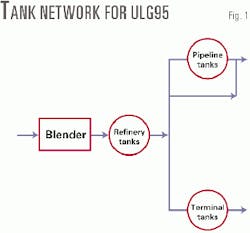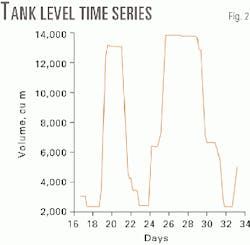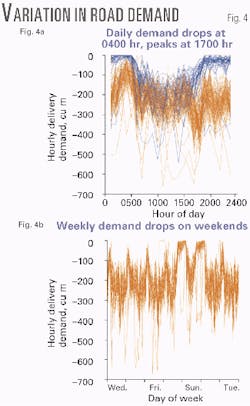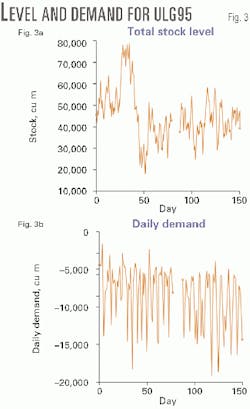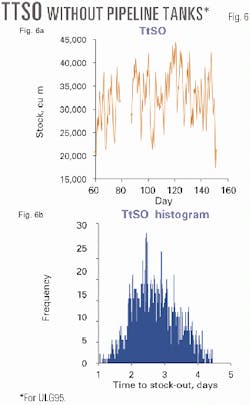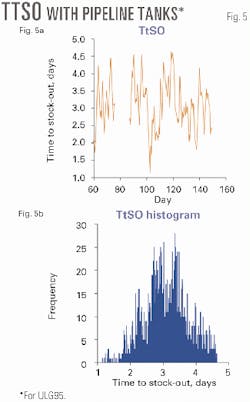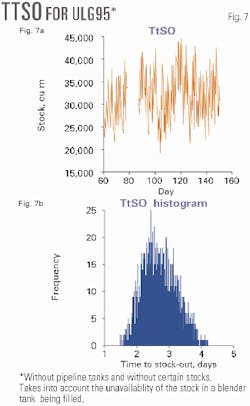A study identified significant margin improvements in stock-handling efficiency by minimizing buffer stocks and reducing storage facilities at Shell's Stanlow refinery in Cheshire, UK.
In line with this study, other process plants can reduce their inventory costs by lowering stock working capital.
In its investigation of the Stanlow refinery, Shell Global Solutions pinpointed potential reductions in white-oil finished-good stocks equivalent to $8 million, without any reduction in the security of supply to customers.
The team's statistical approach yielded insights into scheduling, stock management, and process optimization within general manufacturing processes. The approach is applicable to nonstationary tankage and can optimize run lengths and product quality for multimode, batch processes.
The aim of the study was to discover how a clear view of current stock-handling practice could routinely minimize products and intermediate stock holdings.
Statistical approach
The program undertaken by Shell was part of a major initiative to develop powerful stock-optimization tools. It focused on methods to quantify the distribution of stocks between various sets of storage tanks and the distribution of time to stock-out (TtSO) in response to actual demand.
At the same time, the team of statisticians and experts in oil movements and scheduling who conducted the study estimated the effects of different operating scenarios on stock levels and the risk of stock-out. An additional goal was to understand key drivers leading to stock-level variations.
The team's approach was entirely statistical, requiring no numerical simulations or forecasts.
The approach proved to be a direct correlation between actual, historical tank-level measurements and time stock-handling performance. As a result, the team showed that analysis of historical inventory data enables the generation of stock-performance models.
The team paid particular attention to the performance features of flow rates into and out of the system and the TtSO distribution.
It is now apparent that statistical methods applied to the data available routinely on most plants can reveal new routes to tangible bottom-line business gains through lower contingency stock holdings. The team developed software to make the methodology transportable to different sites.
Significantly, Shell Global Solutions took into account the overall reaction to any incidents in the supply chain, rather than simply focusing on a stand-alone assessment of a plant's stock requirements. Its approach also implicitly took into account the schedulers' actions to balance demand with available production.
Because the approach is based on actual tank-level measurements from which flow rates and TtSO distribution are derived, it enables a complete picture of current stock-handling policy to be generated and stock variability to be not only estimated but also clearly visualized.
This allows underlying drivers of variability to be identified and understood. At the same time, the potential to explore a range of possible stock-handling scenarios and quantify their effects on relative risk and reliability is created.
Among the various changes to current stock-handling practices and distribution strategies so far explored, the team identified substantial operational stock-level reductions for the Stanlow refinery.
For example, in the case of premium gasoline (ULG95), some scenarios predicted that a 20% stock reduction, a value of $2 million, was possible. The combined benefit of stock reduction for white-oil finished products could be as high as $8 million.
Study method
It is possible to calculate entrance and exit flow rates for specific tanks and the entire tank network using tank-level data alone. From these, the team can estimate TtSOs.
The simple nature of tank operations makes a relatively thorough analysis of stock variability possible. At any time, individual storage tanks are being filled, being emptied, or sitting at a constant level. These three states very rarely coincide.
The team considered the Stanlow refinery's ULG95 tank network in detail. The refinery stores production from in-line blenders in four blender tanks before transferring it to pipeline or delivery (road or sea) storage tanks (Fig. 1).
The operators fill and empty the tanks at a roughly constant rate. When tanks are not being filled or emptied, their levels are normally constant while quality control checks are carried out (Fig. 2).
The refinery almost always fills and empties the tanks in sequence; rarely does it empty two tanks simultaneously. Premium motor gasoline, automotive gas oil, and kerosine tank networks are similar.
After data cleaning-that is, screening and modification of measured data to remove values which make no physical sense-the team can calculate hourly flow rates from the differences in tank-level data. At this stage, the team can explore many characteristics of individual and combined tank levels and flow rates, including:
- Time trends and distribution of stock levels.
- Time trends and distribution of production and demand.
- Mass balances (for consistency and identification of export and import events).
- Tankage utilization and periods of inactivity.
- Daily and weekly patterns.
- Demand and production-led changes in tank use (including pump and run events).
It is also possible to quantify the effect of production and demand characteristics on stock-level patterns.
Estimating TtSO
The team can use historic data for total tank levels and demand to calculate the distribution of TtSO and how it changes as a function of time. For the study period, tank levels and demands (both current and future) for the whole tank network were known. With this information, the team can estimate real-time, actual TtSO and its variability over the whole network.
This approach automatically accommodates the effects of real production disruption, demand changes, and scheduling responses as they happen. More-classical methods of analysis are based on broad assumptions of average production, demand, and other factors. Shell's approach has similar advantages over simulations that use assumed statistical distributions.
Exploring different scenarios
Access to flow and level data for individual tanks gives the team the flexibility to examine different operating scenarios. For example, the team may consider removal of a specific tank or the resultant overall reduction in stock levels.
Flow and level data also allow the operators to understand the effects of production and demand-pattern changes. A specific case considered was the removal of all pipeline tanks for ULG95; blender-refinery tanks directly satisfied the pipeline demand instead.
With pipeline tanks in use, the mean utilization of each of the blender, pipeline, and terminal tanks was 43%, 50%, and 61%, respectively. Overall network utilization was 48%. Figs. 3a and 3b show the variations of total stock level and daily demand, respectively, for ULG95.
Because a planned turnaround and stock build-up occurred up to day 60, the period for days 61 to 150 was considered steady state. Daily and weekly road demand patterns were evident (Figs. 4a and 4b), with clear peaks and troughs visible, including a fall in demand at weekends.
Using total stock level and demand (for Fig. 3), the team calculated the behavior of TtSO as a function of time (Figs. 5a and 5b).
If the ULG95 tank network were operated without pipeline tanks, demand being satisfied directly from the blender tanks, there would be a resulting substantial reduction in average total stock, of about 8,000 cu m/day (Fig. 6a), and a corresponding change in TtSO output from 3 to 2.5 days (Fig. 6b).
The difference of 8,000 cu m/day results from comparing the average of Fig. 3a (actual operation with pipeline tanks) with that of Fig. 6a (no pipeline tanks).
These calculations show how an operation like the Stanlow refinery can further be trimmed to achieve better performance.
This hypothetical change in practice (Figs. 5 and 6) shows that all parts on the TtSO distribution curve are reduced by 12 hr from the current operation. Even in this theoretical case, however, there would have been no stock-out. Assuming future operations to be adequately represented by this period, the probability of a future stock-out remains very low.
Practical operational and contingency factors-retention periods, build-ups prior to shutdowns, and dead tank-filling time-must be added to this analysis. The actual stock availability for ULG95 at the refinery became even lower in these conditions.
A revised calculation of TtSO moved the distribution even further to the left, reducing mean availability stock in the system by about 5,000 cu m (Figs. 7a and 7b). The difference of 5,000 cu m is the result of comparing the average of Fig. 6a (no pipeline tanks) with that of Fig. 7a (no pipelines tanks and unaccessible stock).
Similar gains were identified for premium motor gasoline, automotive gas oil, and kerosine stock levels at the refinery.
The authors
Tom Cleary is a refinery production planner with Shell (UK) Oil Products, Stanlow, and has responsibility for day-to-day production planning to meet customer requirements. He has more than 25 years' experience in various aspects of refining, distribution, and supply planning.
Allan Sleight, at the time of writing, worked with Shell (UK) Oil Products, Stanlow, in the oil movements technical support group where he was responsible for data collection, movement systems, and design and operation. He holds a BSc in chemical engineering from Imperial College of Science, Technology and Medicine, the University of London.
Philip Jonathan has been a chartered statistician with Shell Global Solutions, Chester, UK, since 1996. Previously he worked for 3 years in ocean engineering and before that in molecular modeling. Jonathan holds a BSc in applied mathematics and a PhD in ion physics from the University of Wales, UK.
Paul Blackhurst is a chartered chemical engineer with Shell Global Solutions, Chester, UK. He has more than 15 years' experience in research and manufacturing, including fuel and combustion research, refining re-instrumentation projects, process modeling, advanced process control, and real-time optimization. Blackhurst holds an MSc in chemical engineering and process automation from the University of Sheffield.
Kees den Heijer is a statistician working with Shell Global Solutions, Amsterdam, The Netherlands. Den Heijer has more than 20 years of experience within Shell companies and has specialized in the areas of statistics and stochastic operations research. He received his statistical education from the Dutch Statistical Society (Statistician Vereniging Voor Statistiek).
